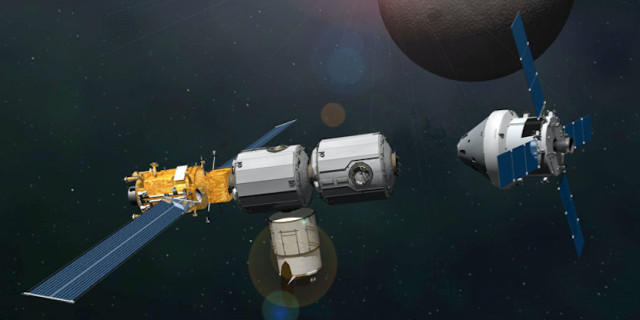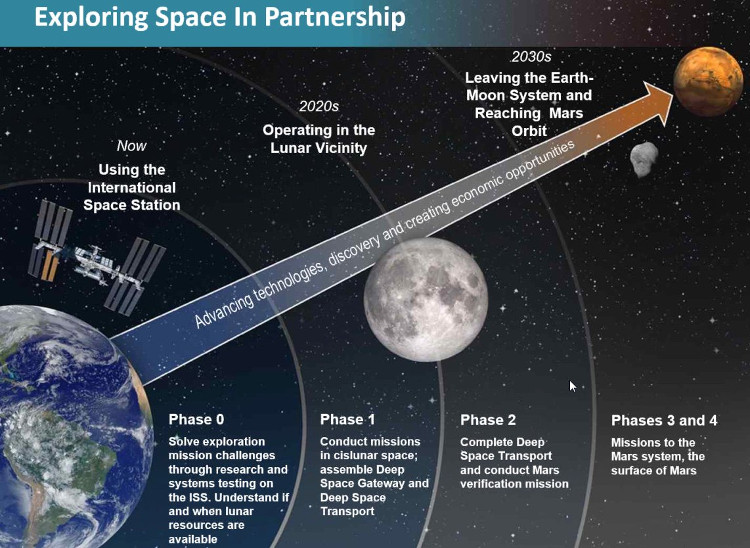ISS International Space Station is about to end its historic mission
NASA and its international partners are taking steps to build a new human home in space. The new space station in the future will replace ISS when the station stops operating in 2020.
In the new era of human space, aviation agencies are constantly building new works in space to support the human journey to distant planets. The future space station planned by NASA will be a stepping stone to this process.
A lot of ideas about new space stations have been put in place. Most notable is the idea of a space station moving in the orbit of the Moon, which will be a hub for human missions to further planets without returning to Earth.

NASA is planning to build a space station that moves around the Moon's orbit.(Photo: Russian Space Web).
This new space station is designed to have an egg shape, about 1,500km and 70,000km, and will be sent directly to the Moon with just one launch from Earth.
NASA engineers and their colleagues from four other aviation agencies have been working together on this project over the years. But it's all a secret drawing, unpublished with public opinion and not submitted to government officials.
If everything goes as planned, then this project will be launched in 2023. First, a robot shaped like a bus called PPB will be launched and revolved around the Moon. Two years later, a pair of cylindrical modules 4.5 meters wide and 5 meters long, weighing no more than 10 tons will be launched and connected to PPB.
And finally on the next 90 days, they will put the house designed for astronauts to stay up and connect them all together. In addition, a Russian-made gas lock module will also be added in the mid-2020s to make astronauts walk to space much easier.

The next steps in the mission to bring people to Mars in the 2030s. (Photo: NASA).
On the outside, both modules will be covered with a thick layer of material and the heat sink is twice as efficient as the anti-meteorite armor, and there are four connecting ports that can be bonded together. future trains arriving at the space station.
The Moon's orbital area is less cosmic waste than Earth's orbit, so engineers will consider designing thinner walls because they will not suffer too many bumps.
Inside, everything is meticulously designed to reduce volume and maximize space. The dining table will be folded after each meal and the bedtime may be inflated or removed whenever necessary. The refrigerator serves as a kitchen appliance and an archive of scientific specimens.

All modules and equipment are assembled to create the first space station that moves around the Moon.(Photo: Russian Space Web).
The biggest effort is the process of recycling and reusing water and oxygen and other resources and energy on the station. Waste when thrown into space will carry oxygen in the station, so engineers have designed a recycling area and reclaimed the oxygen in the back before it was officially disposed of.
Meanwhile, transportation to the station is still a controversial issue. Each crew will move to different points of the station when it moves around the Moon's orbit with a dedicated vehicle, but it is a ship of a private company or a government organization that has not yet been determined.
The ultimate goal of this ambitious project is the more than a year of space exploration going to Mars. To make this a reality, NASA needs a completely new 20-ton rocket in the second half of the 2020s.

The International Space Station (ISS) will end its 30-year history in the late 2020s. (Photo: NASA).
This new space station is a good place for astronauts to train and get used to the environment. In addition, the station is also a landing zone for manned robots or spacecraft missions from the Moon or asteroids.
Anyway, ISS is about to complete its 30-year mission. The shutdown of the space station will close a chapter in human discovery history, but will usher in a new era with a lot of promising aspects that need NASA and mining partners.
- Video of Atlantis ship off the ISS station
- How big is the International Space Station (ISS)?
- International space station increased altitude by 2km
- Dragon ships successfully assembled with ISS
- Private spacecraft landed in the sea, completing the historic mission
- ISS will rest in the Pacific Ocean
- Russia's monopoly of ISS
- Visit 'the longest road' on the ISS International Space Station
- Atlantis launched into space
- Russian cargo spaceship resting in the ocean
- Space shuttle Endeavor returns safely to earth
- NASA opened the International Space Station for ... tourists and film makers from 2020
 Van Allen's belt and evidence that the Apollo 11 mission to the Moon was myth
Van Allen's belt and evidence that the Apollo 11 mission to the Moon was myth The levels of civilization in the universe (Kardashev scale)
The levels of civilization in the universe (Kardashev scale) Today Mars, the sun and the Earth are aligned
Today Mars, the sun and the Earth are aligned The Amazon owner announced a secret plan to build a space base for thousands of people
The Amazon owner announced a secret plan to build a space base for thousands of people